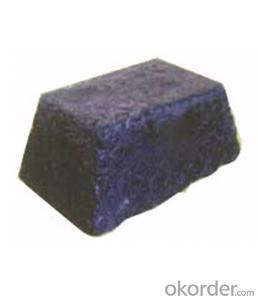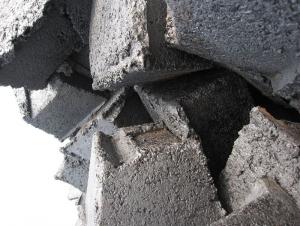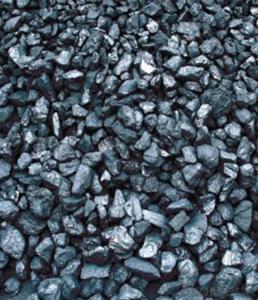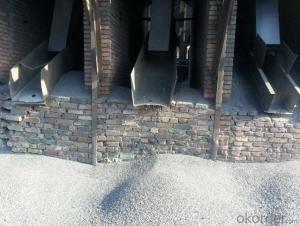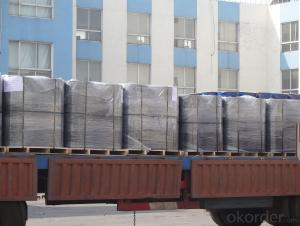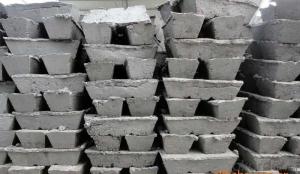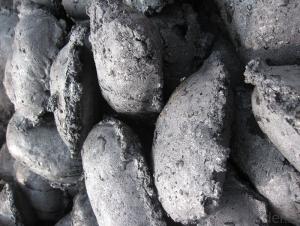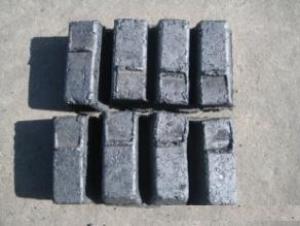Low Ash Carbon Electrode Paste -Ash4 Cheap And Good
- Loading Port:
- China main port
- Payment Terms:
- TT OR LC
- Min Order Qty:
- 0 m.t.
- Supply Capability:
- 20000 m.t./month
OKorder Service Pledge
OKorder Financial Service
You Might Also Like
Main Function And Features
1) Low ash content
2) Good electric and thermal conductivity
3) High resistance to temperature
4) Stable quality
5) Reasonable price
6) Size:all kinds of electrode paste
7) Accord customer's reques change
Introduction To Products
1) Carbon Electrode Paste is a self-baking electrode used in submerged arc furnaces for delivering power to the charge mix.
2) Electrode Paste is added to the top of the electrode column in either cylindrical or briquette form.
3) As the paste moves down the electrode column the temperature increase causes the paste to melt and subsequently bake
forming a block of electrically conductive carbon.
4) Electrode Paste is essentially a mix of Electrically Calcined Anthracite (ECA) or Calcined Petroleum Coke (CPC) with Coal
Tar Pitch.
Application Range
1) Be used as the electrode for self roasting in the iron-alloy furnace and acetylene furnace.
2) Amorphous graphite powder--applied in steel making,fireproof material,casting coating.
3) Calcined petroleum coke--used in foundry,metallurgy,carbon paste,graphite electrode.
4) Carbon anode scrap--used as smelting fuel for copper smelting industry.
5) Carbon electrode paste--applied in iron alloy,calcium carbide,ferroalloy,ferromanganese.
Specification
Specification/Item |
|
|
|
|
|
|
Ash | 4.0%max | 5.0%max | 6.0%max | 7.0% Max | 9.0% Max | 11.0% Max |
VM | 12.0%-15.5% | 12.0%-15.5% | 12.0%-15.5% | 9.5.0%-13.5% | 11.5%-15.5% | 11.5%-15.5% |
Compress Strength | 18.0Mpa Min | 17.0Mpa Min | 15.7Mpa Min | 19.6Mpa Min | 19.6Mpa Min | 19.6Mpa Min |
Specific Resistance | 65μΩm Max | 68μΩm Max | 75μΩm Max | 80μΩm Max | 90μΩm Max | 90μΩm Max |
Bulk Density | 1.38G/CM3 Min | 1.38G/CM3 Min | 1.38G/CM3 Min | 1.38G/CM3 Min | 1.38G/CM3 Min | 1.38G/CM3 Min |
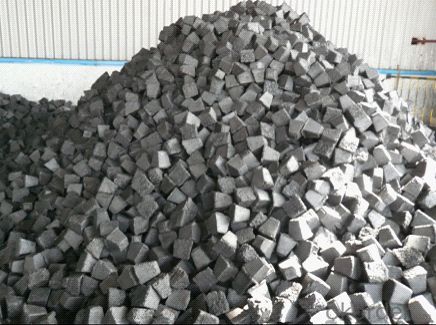
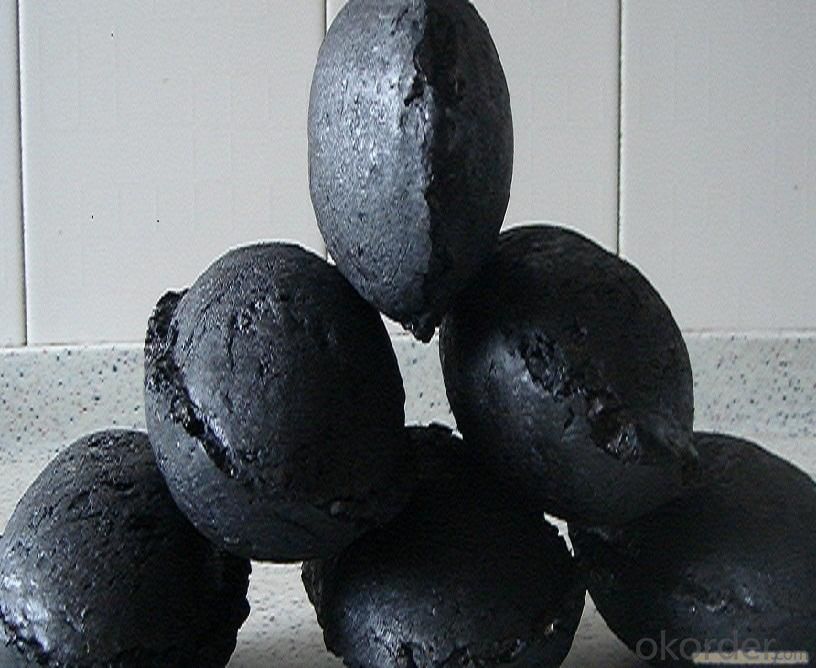
- Q: How does carbon contribute to the structure of DNA?
- The structure of DNA relies heavily on carbon, as it plays a critical role in its composition. Carbon is a crucial element in the formation of the sugar-phosphate backbone, which is an integral part of the DNA molecule. This backbone consists of alternating sugar and phosphate molecules, with the sugar molecule being deoxyribose in DNA. Deoxyribose sugar contains five carbon atoms, making carbon a significant component in its structure. These carbon atoms provide stability and rigidity to the backbone, ensuring the overall structure of the DNA molecule remains intact. Additionally, carbon also contributes to the formation of the nitrogenous bases that form the ladder-like structure of DNA. There are four nitrogenous bases in DNA: adenine (A), guanine (G), cytosine (C), and thymine (T). Carbon atoms are present in the structure of each of these bases, giving them their distinct chemical properties. Various functional groups containing carbon, such as amino and keto groups, actively participate in hydrogen bonding and stacking interactions that determine the base pairing within the DNA double helix. To summarize, carbon is an indispensable element in the structure of DNA. It not only provides stability and rigidity to the sugar-phosphate backbone but also plays a crucial role in the formation of the nitrogenous bases. The unique properties of carbon enable DNA to maintain its double helix structure and facilitate the accurate transmission of genetic information.
- Q: What are the impacts of carbon emissions on the stability of polar ice caps?
- Carbon emissions have significant impacts on the stability of polar ice caps. The primary cause of these emissions is the burning of fossil fuels, which releases large amounts of carbon dioxide into the atmosphere. As a greenhouse gas, carbon dioxide traps heat and contributes to global warming and climate change. This, in turn, leads to the melting of polar ice caps. The ice caps in the polar regions are highly sensitive to changes in temperature. As the Earth's temperature rises due to increased carbon emissions, the polar ice caps experience accelerated melting. This causes a rise in sea levels, which has consequences for coastal regions worldwide. Rising sea levels can lead to increased flooding, erosion, and the loss of valuable coastal ecosystems. Moreover, the stability of polar ice caps is crucial for maintaining the Earth's climate balance. The ice caps reflect sunlight back into space, acting as a natural cooling mechanism for the planet. As they melt, less sunlight is reflected, and more is absorbed by the Earth's surface, exacerbating the warming effect. This creates a feedback loop, where the melting of ice caps leads to further warming, causing even more ice to melt. The impacts of carbon emissions on polar ice caps are not limited to rising sea levels and climate change. The loss of ice also affects the delicate balance of ecosystems in these regions. Polar ice caps provide habitat and a food source for a diverse range of organisms, including polar bears, seals, and various species of birds. The melting of ice disrupts these ecosystems, leading to declines in wildlife populations and potential extinctions. Moreover, the melting of polar ice caps also affects global ocean currents and weather patterns. The cold, dense water that forms from melting ice sinks to the bottom of the ocean and drives important oceanic circulation patterns. Changes in these patterns can have far-reaching consequences, including altering the distribution of marine species, impacting fisheries, and influencing regional climates. To mitigate the impacts of carbon emissions on polar ice caps, it is crucial to reduce greenhouse gas emissions and transition to cleaner and renewable energy sources. International efforts, such as the Paris Agreement, aim to limit global warming and reduce carbon emissions to prevent further ice cap melting. Additionally, supporting research and monitoring programs in polar regions can help us better understand these complex systems and develop effective strategies for their conservation.
- Q: How does carbon affect the growth of plants?
- Plants rely on carbon for their growth and development, as it is a vital element. It is found in organic compounds like carbohydrates, proteins, and lipids, which are essential for plants' metabolic processes. Photosynthesis allows plants to convert carbon dioxide into glucose and other sugars, providing them with energy for various functions and growth. Additionally, carbon plays a crucial part in building plant structures. Cellulose, a complex carbohydrate composed of carbon, hydrogen, and oxygen, gives rigidity and support to plant cell walls, enabling them to maintain their shape and withstand mechanical stress. Lignin, another carbon-based compound, strengthens stems and roots, allowing plants to grow upright and resist bending or breaking. Moreover, carbon has a role in regulating plant hormones and signaling molecules that control growth and development. It acts as a foundation for the synthesis of various plant hormones, such as auxins, gibberellins, and cytokinins, which influence cell division, elongation, and differentiation. To summarize, carbon is crucial for plant growth as it fuels their energy needs, provides structural support, and participates in hormonal regulation. Understanding the significance of carbon in plant growth is essential for optimizing agricultural practices, ensuring healthy crop yields, and mitigating the impact of climate change on plant ecosystems.
- Q: How does deforestation contribute to carbon dioxide levels in the atmosphere?
- Deforestation plays a significant role in contributing to increased carbon dioxide levels in the atmosphere. Trees act as natural carbon sinks, absorbing carbon dioxide during photosynthesis and storing it in their trunks, branches, and leaves. When forests are cleared or burned down for various purposes such as agriculture, logging, or urbanization, the stored carbon is released back into the atmosphere as carbon dioxide. The removal of trees directly leads to a reduction in the planet's capacity to absorb carbon dioxide, resulting in an imbalance in the carbon cycle. Additionally, deforestation disrupts the carbon cycle by inhibiting the process of photosynthesis, which is essential for converting carbon dioxide into oxygen and organic compounds. Moreover, deforestation indirectly contributes to increased carbon dioxide levels in the atmosphere through the decomposition of organic matter. When trees are cut down or burned, the stored carbon they contain is released into the atmosphere as carbon dioxide, intensifying greenhouse gas emissions. Furthermore, deforestation also impacts the water cycle, leading to drier conditions in the affected areas. This dries out the soil, making it less suitable for plant growth and reducing the potential for carbon absorption through reforestation efforts. The cumulative effect of deforestation on carbon dioxide levels is significant. According to studies, deforestation accounts for approximately 10-15% of global carbon emissions, making it one of the leading contributors to climate change. The increase in atmospheric carbon dioxide levels, along with other greenhouse gases, contributes to the greenhouse effect, trapping heat in the atmosphere and causing global warming. Addressing deforestation is crucial in mitigating climate change and reducing carbon dioxide levels. Implementing sustainable forestry practices, promoting reforestation efforts, and protecting existing forests are essential steps in preserving carbon sinks and reducing greenhouse gas emissions.
- Q: How does carbon impact the prevalence of wildfires?
- There are several ways in which carbon affects the occurrence of wildfires. First and foremost, carbon dioxide (CO2) is a greenhouse gas that contributes to climate change. As the concentration of CO2 increases in the atmosphere, temperatures rise, resulting in drier conditions in many areas. These dry conditions create a more favorable environment for the ignition and spread of wildfires. Moreover, carbon plays a significant role in the amount of fuel available to feed wildfires. Carbon-based materials, such as dead vegetation, trees, and other organic matter, serve as the main source of fuel for fires. As carbon accumulates in ecosystems, either naturally or through activities like deforestation, the potential fuel for wildfires increases. This increased fuel load can lead to more frequent and intense fires. In addition, carbon has an impact on the health and vitality of forests. Higher levels of atmospheric CO2 can enhance plant growth, resulting in denser vegetation. Although this may seem beneficial, it actually contributes to the intensity and severity of wildfires. Denser vegetation means there is a greater amount of fuel available, especially when combined with the dry conditions caused by climate change. This combination becomes a recipe for more destructive fires. Lastly, the combustion of carbon-based materials during wildfires releases large amounts of carbon dioxide into the atmosphere. This creates a positive feedback loop, as the increased carbon emissions contribute to further climate change, which, in turn, worsens the conditions for wildfires. In summary, carbon plays a critical role in determining the occurrence and severity of wildfires through its impact on climate change, fuel load, forest health, and the release of greenhouse gases during combustion. It is essential to address carbon emissions and implement effective forest management practices in order to mitigate the risks and consequences associated with wildfires.
- Q: How does carbon affect the formation of earthquakes?
- Carbon does not directly affect the formation of earthquakes. Earthquakes are caused by the movement of tectonic plates and the release of accumulated stress in the Earth's crust. Carbon, however, can indirectly influence the frequency and intensity of earthquakes through human activities such as mining and fracking, which can trigger seismic events in certain circumstances.
- Q: What are the advantages of carbon nanotube transistors?
- Traditional silicon-based transistors are outshined by carbon nanotube transistors for several reasons. Firstly, carbon nanotubes boast exceptional electrical properties with their high electron mobility, enabling swift and effortless electron movement. This results in faster switching speeds and higher operating frequencies, making them a perfect fit for high-performance applications like computers and communication devices. Secondly, carbon nanotubes possess an incredibly small size, measuring a mere few nanometers in diameter. This miniature scale allows for the creation of highly compact and densely packed electronic circuits, leading to elevated integration levels and enhanced device functionality. In comparison, silicon transistors pale in comparison as they have feature sizes several orders of magnitude larger. Moreover, carbon nanotubes exhibit superior heat resistance and thermal conductivity compared to silicon. This exceptional trait enables them to withstand higher temperatures without degradation, resulting in more efficient operation and a reduced need for elaborate cooling systems. Additionally, their ability to endure harsh environments makes them highly suitable for aerospace, automotive, and defense applications. Furthermore, carbon nanotubes are remarkably robust and flexible. They can be bent and stretched without breaking, making them ideal for use in flexible electronics and wearable devices. Their mechanical strength ensures long-term stability and reliability, ultimately leading to improved device performance and longevity. Lastly, carbon nanotube transistors can be fabricated using existing manufacturing processes, making them compatible with current semiconductor technologies. This compatibility allows for their seamless integration into existing electronic systems without the need for significant modifications, thereby reducing both cost and implementation time. All in all, the myriad advantages of carbon nanotube transistors, including their exceptional electrical performance, small size, thermal stability, mechanical strength, and compatibility with existing manufacturing processes, position them as a promising alternative to traditional silicon transistors for future electronic applications.
- Q: How does carbon dioxide affect waste management processes?
- Carbon dioxide (CO2) has a significant impact on waste management processes. One of the main ways in which it affects waste management is through the decomposition of organic waste. When organic waste, such as food scraps or yard waste, is sent to landfills, it undergoes anaerobic decomposition due to the lack of oxygen. This process produces methane (CH4), a potent greenhouse gas that contributes to climate change. Methane is approximately 25 times more effective at trapping heat in the atmosphere than carbon dioxide over a 100-year period. Therefore, the presence of carbon dioxide in waste management processes indirectly results in increased methane emissions, exacerbating the greenhouse effect. Moreover, carbon dioxide emissions from waste management activities can occur during the transportation and disposal of waste. The collection and transportation of waste to landfills or incineration facilities require the use of vehicles that typically run on fossil fuels, releasing carbon dioxide into the atmosphere. Additionally, waste incineration generates carbon dioxide emissions, as the combustion process produces CO2 as a byproduct. To mitigate the impact of carbon dioxide on waste management, several strategies can be employed. Firstly, reducing the amount of waste generated through waste reduction and recycling efforts can help minimize the need for landfilling or incineration, thereby reducing carbon dioxide emissions associated with waste management. Furthermore, implementing waste-to-energy technologies, such as anaerobic digestion or landfill gas capture, can help to harness the energy potential of organic waste, while simultaneously reducing methane emissions. Anaerobic digestion converts organic waste into biogas, which can be used to generate electricity or heat, while landfill gas capture systems collect methane emitted from landfills and use it for energy production. Lastly, transitioning to low-carbon transportation options, such as electric or hybrid vehicles, for waste collection and transportation can help reduce carbon dioxide emissions associated with waste management processes. In conclusion, carbon dioxide affects waste management processes by contributing to the production of methane during the decomposition of organic waste and through emissions generated during waste transportation and disposal. By implementing waste reduction strategies, waste-to-energy technologies, and transitioning to low-carbon transportation options, the impact of carbon dioxide on waste management can be minimized, resulting in more sustainable and environmentally friendly waste management practices.
- Q: What is the concept of carbon equivalent? What is the relationship between carbon equivalent and weldability?
- In order to facilitate the expression of strength properties of these materials and welding performance simply to carbon equivalent to said through the statistics of test data.
- Q: How does carbon dioxide affect the health of marine organisms?
- Carbon dioxide can have significant impacts on the health of marine organisms. When carbon dioxide is absorbed by seawater, it undergoes a chemical reaction that causes the water to become more acidic. This process is known as ocean acidification. Ocean acidification interferes with the ability of many marine organisms to build and maintain their shells and skeletons. For instance, corals, oysters, and other shellfish rely on calcium carbonate to form their protective structures. However, under more acidic conditions, the availability of carbonate ions decreases, making it harder for these organisms to calcify. This can lead to weakened shells, reduced growth rates, and increased vulnerability to predation and disease. Furthermore, ocean acidification can also disrupt the reproductive and developmental processes of marine organisms. For example, some studies have shown that increased CO2 levels can affect the ability of fish to locate their preferred habitats, find mates, and successfully reproduce. Additionally, some species of fish and invertebrates have been found to exhibit altered behavior and impaired sensory functions under high CO2 conditions. In addition to these direct effects, ocean acidification can also have indirect consequences for marine organisms by disrupting entire ecosystems. For instance, the decline in coral reefs due to reduced calcification can have cascading effects on the whole reef ecosystem, impacting the biodiversity and productivity of these important marine habitats. Overall, the increasing levels of carbon dioxide in the atmosphere are not only contributing to global climate change but also leading to ocean acidification, which poses significant threats to the health and survival of many marine organisms. It is crucial to address and mitigate the causes of carbon dioxide emissions in order to protect the delicate balance of our oceans and the diverse range of species that depend on them for their survival.
Send your message to us
Low Ash Carbon Electrode Paste -Ash4 Cheap And Good
- Loading Port:
- China main port
- Payment Terms:
- TT OR LC
- Min Order Qty:
- 0 m.t.
- Supply Capability:
- 20000 m.t./month
OKorder Service Pledge
OKorder Financial Service
Similar products
Hot products
Hot Searches

